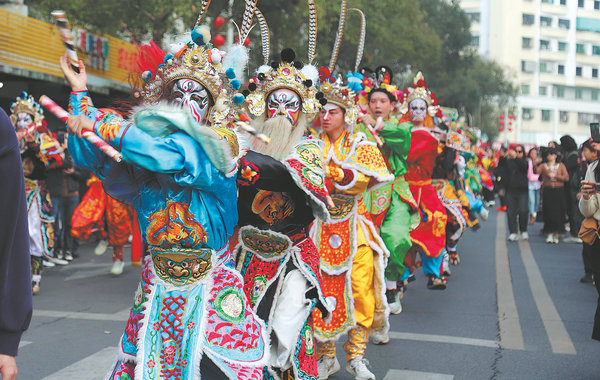

Interest triggered
Cao Lei, a 31-year-old white-collar worker from Nanchang, Jiangxi province, is testament to this trend.
Her interest in traditional Chinese culture was kindled after she watched short videos featuring Yingge Dance, a folk dance with a 300-year history from the Chaoshan region of Guangdong province.
This interest sparked Cao's quest to explore traditional cultures from different parts of the country.
"I initially delved into traditional culture out of curiosity. Over time, I sensed the festive atmosphere was fading during the Spring Festival. To understand how people in these areas celebrate Chinese New Year, I trawled online platforms to seek traditional customs that have been preserved, " she said.
After watching short videos extensively online, Cao became well-versed in the intricacies of Yingge Dance.
"It has a strong sense of tradition. Performers undergo rigorous training from a young age, and during Spring Festival, performance teams in every village dance to celebrate the occasion, creating a lively atmosphere," Cao said.
This year during the holiday, she began watching videos of Youshen, a Spring Festival custom from Southeast China, and quickly warmed to the talent of the young performers.
Youshen, which translates as "wandering gods", is a folk tradition from rural areas of Fujian province that dates to the Ming Dynasty (1368-1644). Villages hold joyous parades and other celebrations to welcome the start of spring, and pray to local gods and deities. Every year, they carry large sculptures of deities through streets and alleys to dispel evil, avert disaster, and seek blessings.
"I never thought traditional customs and performances could be so attractive and interesting," Cao said.
The online world has prompted young people such as Cao to explore traditional cultures and history.
"Last year, I visited an exhibition at Jiangxi Provincial Museum that showcased paintings of porcelain in Jiangxi alongside Dunhuang murals from Gansu province," Cao said.
Latest statistics released by the National Cultural Heritage Administration show that during Spring Festival this year (from Feb 10 to 17), museums nationwide received a total of 73.58 million visitors, a 98.6 percent year-on-year rise.
Su Qin, 34, a freelance guide at Liaoning Provincial Museum, said that in recent years, there has been a noticeable surge in the number of young visitors to the institution.
"The internet has played a significant role. The popularity of the summer destination of Zibo in Shandong province, the winter attractions of Harbin, Heilongjiang province, and the recent enthusiasm for cultural and historical relics are the combined result of young people's pursuit of China-chic (fancy designs mixed with elements of traditional culture), and promotion through social media," he said.
Su identified three main types of visitors to Liaoning Provincial Museum.
First, there are those who visit casually just to take photos and tick the venue off on their list. Second, some visit to attend specific exhibitions. The final group consists of visitors who, after browsing, develop an interest in history and culture before returning for a second or third visit, he said.
"It's not just the post-90s and post-00s generations who are flocking to museums, but even younger visitors. Many of the tour groups I've recently guided consist of young people who bring their children. Since the children need places to explore, museums and art galleries are the perfect solution. They are safe, the kids can learn, and admission is free," he added.